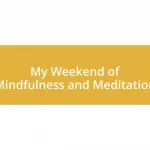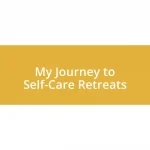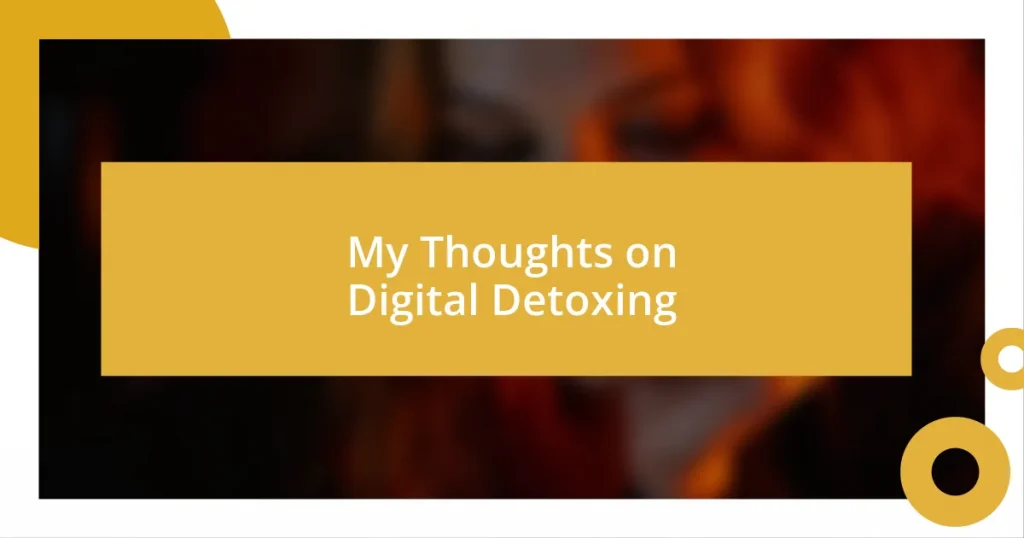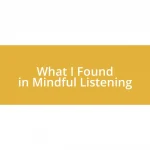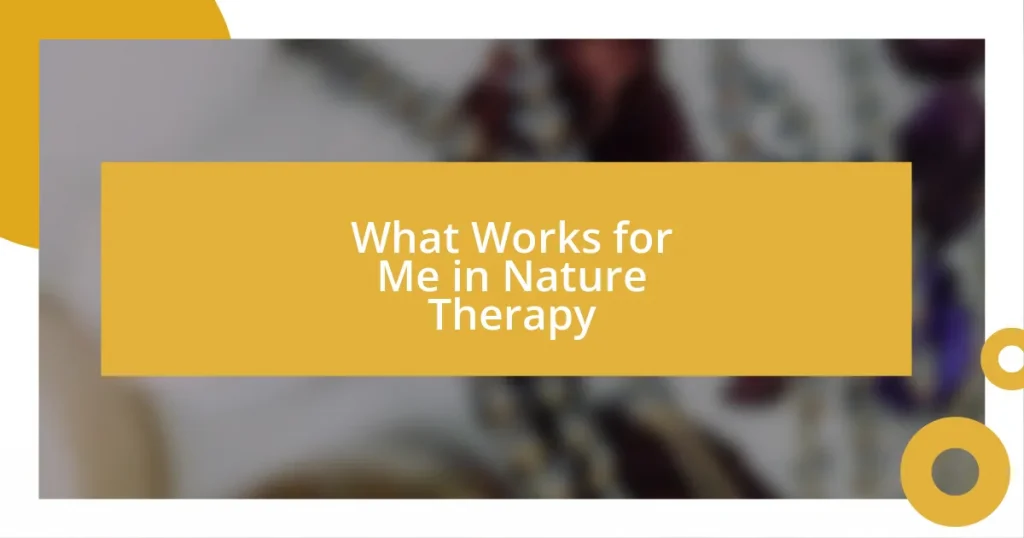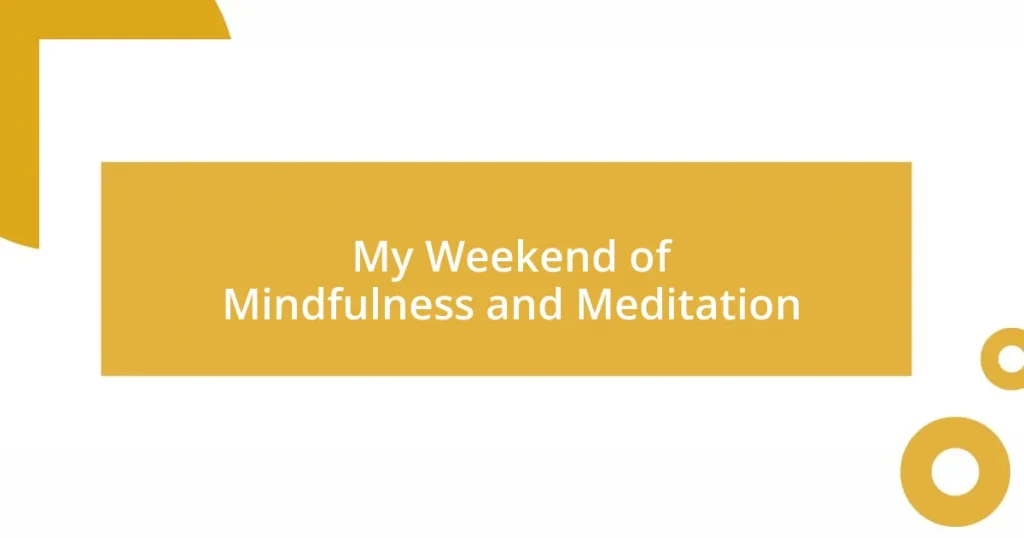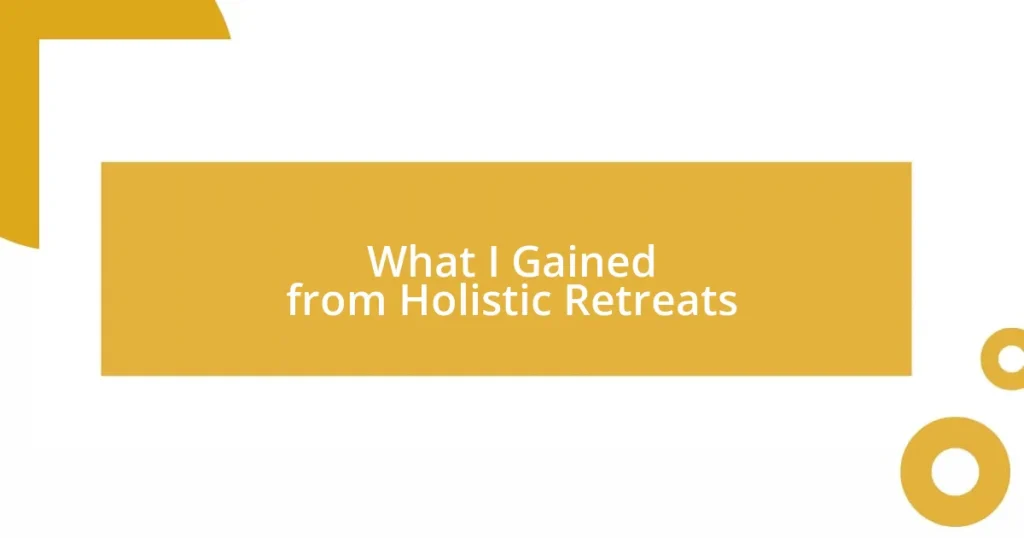Key takeaways:
- Digital detoxing enhances mental clarity, fosters deeper relationships, and reduces anxiety.
- Recognizing signs of digital overload, such as constant fatigue and reduced attention span, is crucial for maintaining balance.
- Setting achievable detox goals and engaging in offline activities can cultivate a healthier relationship with technology.
- Regularly evaluating your digital habits helps maintain long-term balance and address unhealthy patterns.
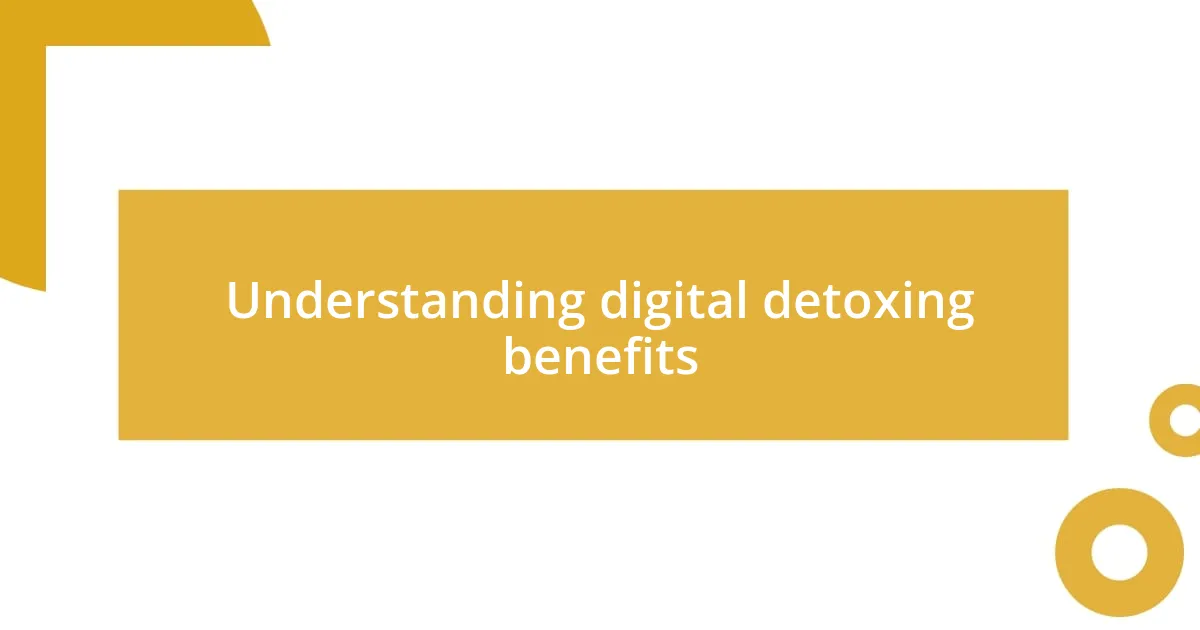
Understanding digital detoxing benefits
When I first embarked on a digital detox, I was surprised to discover just how much mental clarity I gained. The endless scrolling through social media and constant notifications created a fog that clouded my focus. By unplugging, I found a refreshing sense of peace—almost like shedding a heavy coat during a warm spring day.
One of the most profound benefits I experienced was the improvement in my relationships. Without the distraction of my phone, I could engage in deeper conversations with friends and family, fully present in the moment. Doesn’t it feel great to connect without the urge to check messages or snap a quick photo? Those authentic interactions reminded me of the joy that can be found in shared experiences rather than virtual likes.
In addition to fostering relationships, digital detoxing can significantly reduce anxiety levels. Personally, I noticed my stress would often spike when I was bombarded with news alerts and social media updates. After a brief break, I found my mind craved genuine tranquility. Isn’t it fascinating how stepping back from the digital world allows us to reconnect with our own thoughts and feelings more fully?
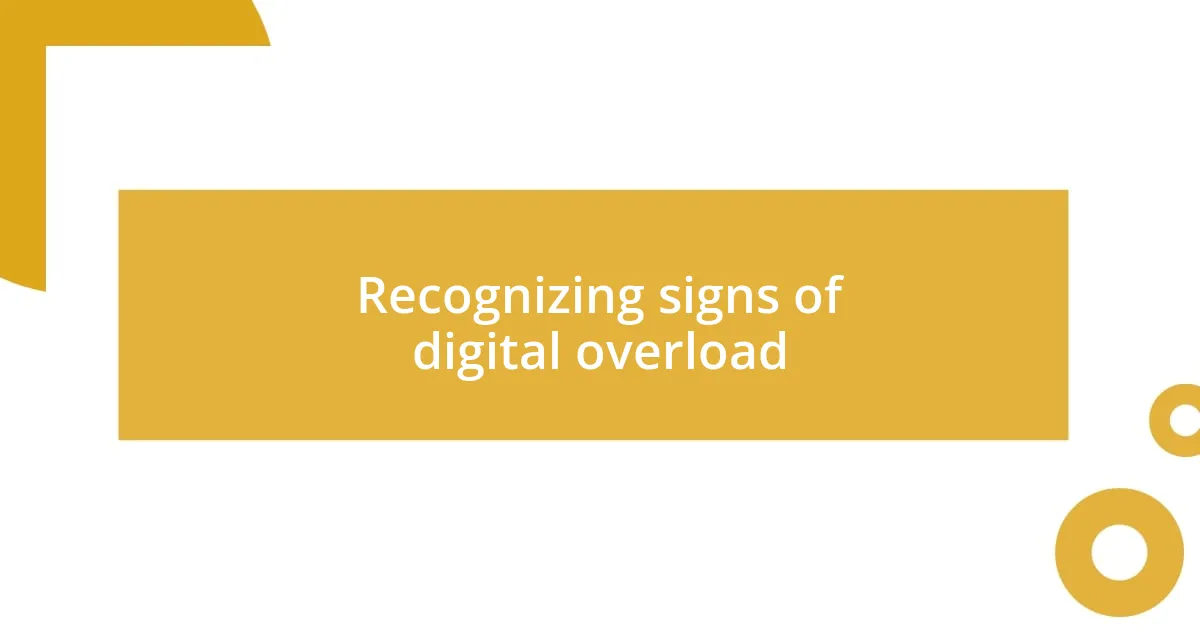
Recognizing signs of digital overload
Recognizing signs of digital overload can be a game changer in our quest for balance. One of the most evident signs for me was the feeling of constant fatigue. I remember days when I’d wake up and immediately reach for my phone, only to feel mentally drained before even getting out of bed. It became overwhelming to the point where I often found myself eagerly waiting for bedtime just to escape the incessant notifications. Have you ever felt that way? It’s almost surreal how our devices become the very source of our exhaustion.
Another clear indicator of digital overload is reduced attention span. I used to sit down with a book but found myself distracted by the pull of my phone. Little did I realize how much that split attention took away from my joy in reading. It’s heartbreaking to think that we can miss out on enriching experiences because of our digital habits. It’s so vital to listen to those internal signals; they often point to a need for a break.
Lastly, I started noticing my emotional responses shifting. Social media would spark unnecessary comparisons and self-doubt, feelings I hadn’t grappled with before. I recalled one evening scrolling through a friend’s posts of her idyllic vacation, which left me feeling inadequate rather than happy for her. A simple reflection on these moments paved the way for my realization that stepping away from the digital noise would help me reclaim my emotional well-being.
| Signs of Digital Overload | Description |
|---|---|
| Constant Fatigue | Feeling mentally drained from continuous device use. |
| Reduced Attention Span | Difficulty focusing on tasks or activities due to distractions. |
| Emotional Reactions | Increased feelings of inadequacy or anxiety from online comparisons. |
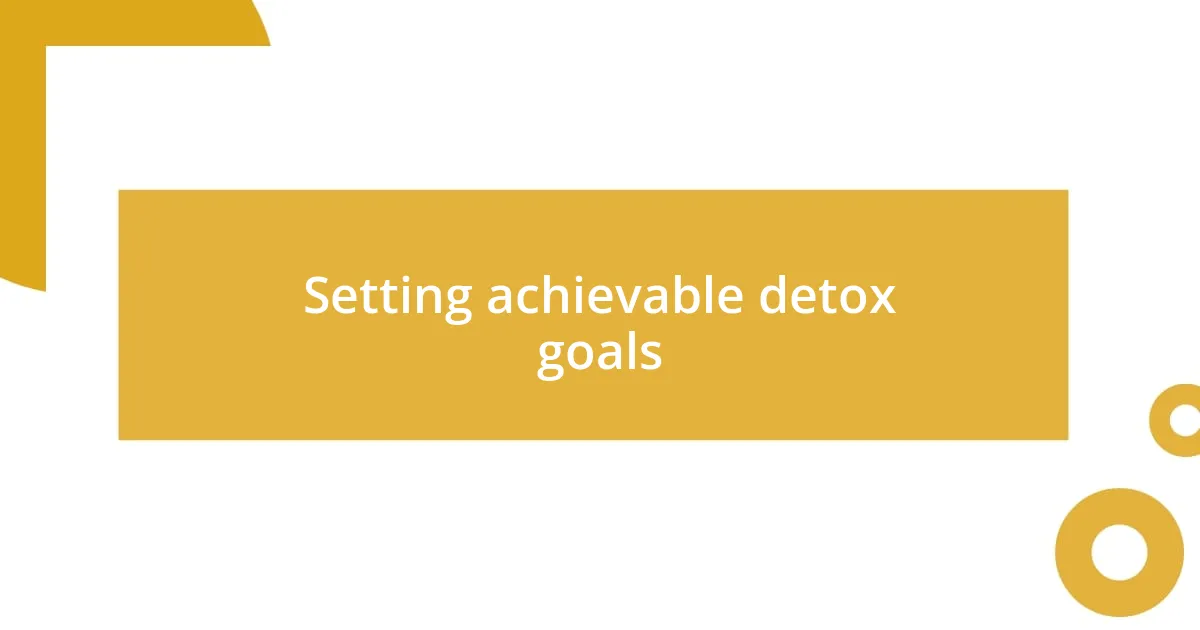
Setting achievable detox goals
Setting achievable goals for a digital detox is essential if you want to experience lasting benefits. When I began this journey, I realized that going cold turkey wasn’t the right approach for me. Instead, I set small, manageable targets. For example, I decided to reduce my screen time by just one hour a day. Surprisingly, even this minor adjustment led to a significant shift in my mindset and energy levels.
Consider these practical steps to help you set your own detox goals:
- Start Small: Limit your social media use by 15-30 minutes a day.
- Designate Tech-Free Zones: Create areas in your home, like the dining room, where devices are not allowed.
- Scheduled Breaks: Pick specific times of the day when you’ll completely unplug to recharge your mind.
- Engage in Offline Activities: Plan regular activities that don’t involve screens, like hiking or reading a book, to replace digital habits gradually.
By taking these incremental steps, you’ll cultivate a healthier relationship with technology—one that surprisingly enhances your overall well-being. Each small victory, like leaving my phone in another room while I enjoyed a meal, became a cherished moment of tranquility.
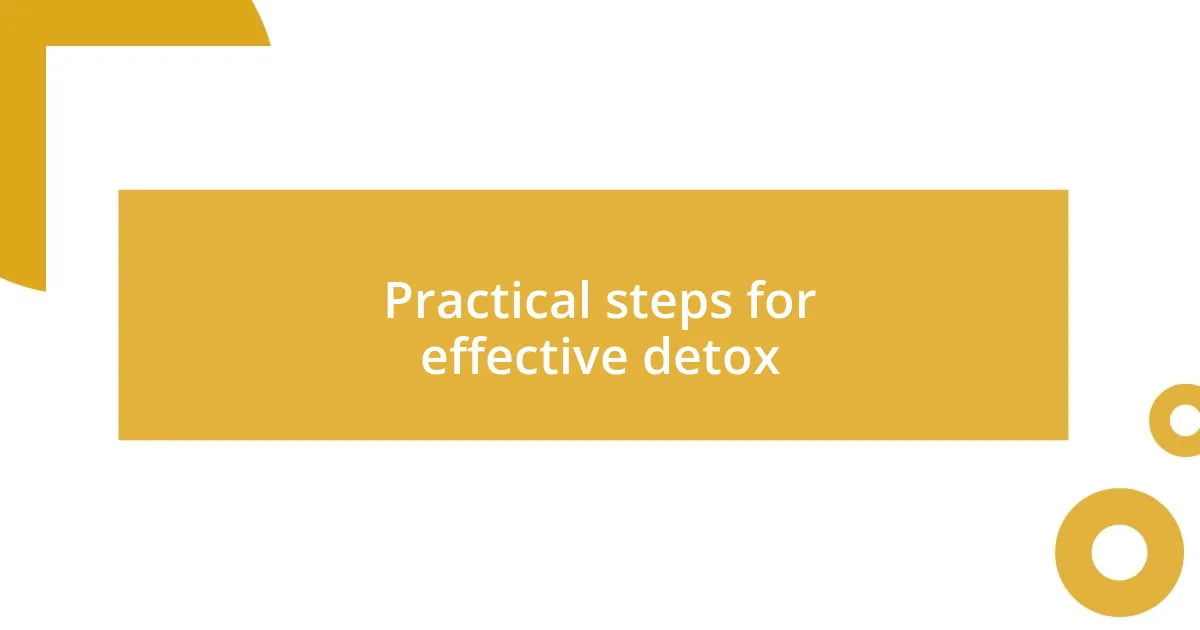
Practical steps for effective detox
To make your digital detox more effective, I found that a clear plan is essential. When I decided to dedicate one weekend each month to a complete digital break, I was surprised by how refreshing it felt. Imagine waking up without the urge to check notifications—what a relief that was! I engaged in activities like cooking and journaling, which not only recharged my mind but also deepened my appreciation for my surroundings. Are you ready to carve out that guilt-free time for yourself?
Another step that really helped me was setting specific ‘tech-free hours,’ especially during meals and right before bed. I remember the first night I left my phone in another room while I dined; it was awkward at first, but soon I found myself immersed in conversations and truly enjoying my food. Doesn’t it feel good to be present? Those hours away from the screen became sacred moments of connection with myself and others.
Lastly, I recommend tracking your progress in a journal. Reflecting on your emotional state as you implement these changes can provide valuable insights. After a few weeks of reduced screen time, I noticed a marked shift in my mood and productivity levels. Have you ever taken the time to journal about your digital habits? I found it to be a powerful tool for self-awareness, making me more mindful about when and how I engage with technology.
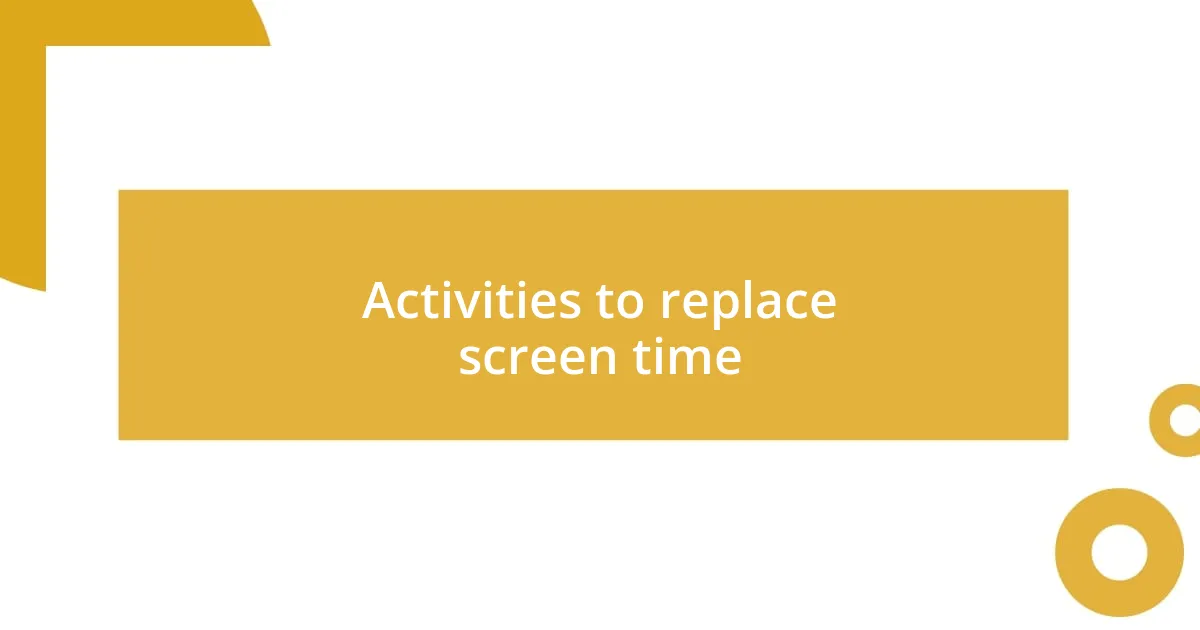
Activities to replace screen time
Finding alternative activities to replace screen time has been a game changer for me. I started with simple things, like taking walks in nature. The moment I stepped outside, breathing in the fresh air and soaking up the sights around me, it felt as if my mind had been cleared. Have you ever noticed how vibrant the world becomes when you’re not glued to a screen? I found this practice of mindfulness to be incredibly grounding.
Another fulfilling activity for me has been reading real books—remember those? Diving into a captivating novel or learning something new from non-fiction is a treasure trove of experience. I recall picking up a book that had been collecting dust on my shelf; each page transported me into different worlds and ideas. It’s amazing how much richness lies just beyond screens, don’t you think? Getting lost in a story not only entertained me but also sparked creativity within my own life.
I also rediscovered the joy of hands-on hobbies like painting and gardening. One evening, I set up a small canvas in my living room and let my instincts guide me, free from digital distractions. I felt a rush of joy with each brushstroke, a newfound freedom that was fun and therapeutic. Isn’t it fascinating how creative activities can sometimes bring clarity and peace? This shift away from screens towards tangible experiences has allowed me to connect more deeply with myself.
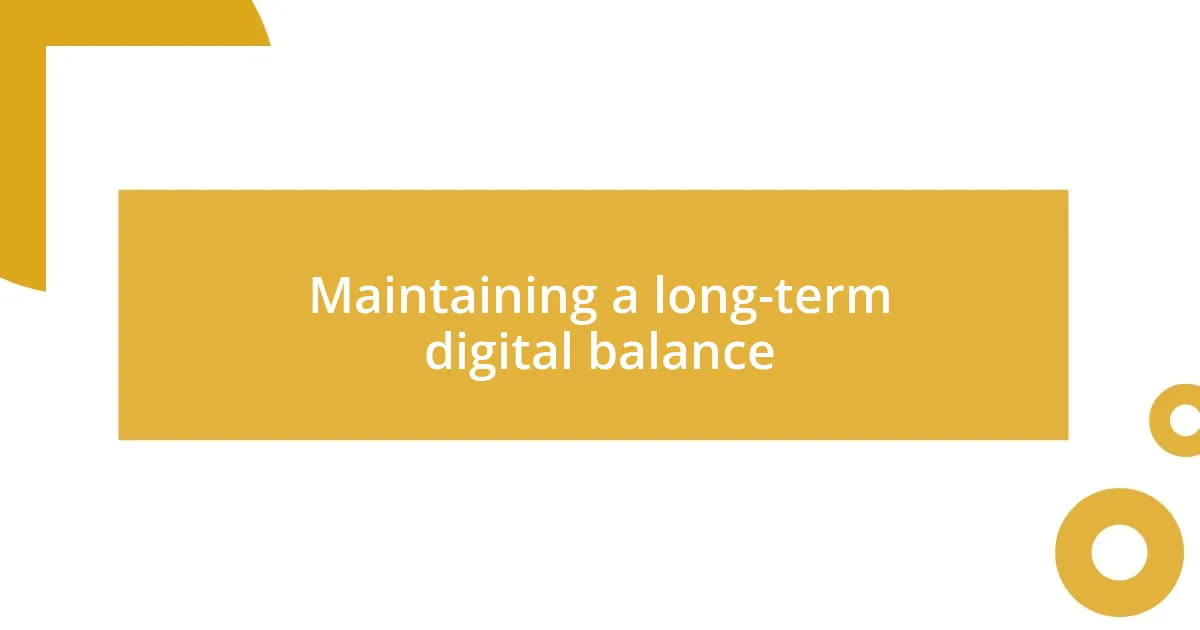
Maintaining a long-term digital balance
Finding a long-term digital balance really revolves around being intentional with technology. I remember the initial thrill of choosing to check my emails only twice a day. At first, it felt freeing, but over time, I noticed how liberating it was to focus on other tasks without the constant pull of alerts. Have you ever felt how calming it is to work uninterrupted? That shift changed not just my productivity, but also my mindset.
Establishing regular digital boundaries has become essential for me. I started designating Sundays as a digital-free zone, which transformed my weekend experience. The first time I embraced this, I rediscovered hobbies I had pushed aside, like playing the guitar and exploring local art exhibits. Don’t you just love the spark of creativity that can come from stepping away from screens? Those Sundays now remind me that a world unfiltered by digital noise is full of vibrant possibilities.
I also find it helpful to periodically reassess my relationship with technology. Every few months, I take a step back and ask myself if my screen time aligns with my values and goals. This practice helped me realize how much scrolling could drain my energy. Have you ever paused to evaluate what you truly gain from your digital habits? This reflection has not only kept me accountable but also empowered me to make informed adjustments whenever I felt myself slipping back into old habits.
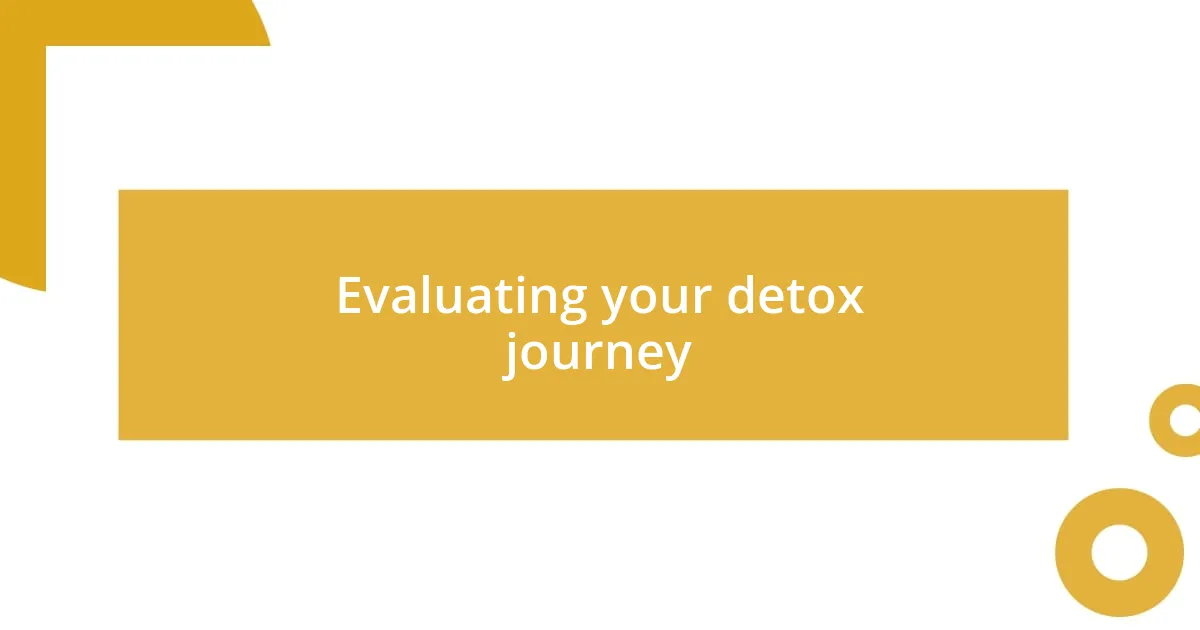
Evaluating your detox journey
Evaluating your detox journey involves honest reflection on your experiences and feelings throughout the process. After a week without screens, I sat down with a journal, pouring out my thoughts. It was enlightening to see how my emotions shifted; I felt lighter and more present. Hasn’t it struck you how an intentional pause can peel back layers of overwhelming noise?
I also recommend checking in with yourself about the habits that formed or changed during your detox. For instance, I realized how much I had grown to appreciate quiet moments like sipping tea while listening to the rustle of leaves. Such tiny rituals became grounding points for me. Have you noticed changes in the way you spend your downtime? Recognizing those shifts can deepen your commitment to a mindful lifestyle.
Lastly, consider how you want to proceed post-detox. I found that certain digital habits subtly crept back, and that awareness was key. I decided to maintain a few boundaries, like keeping my phone in another room during meals. What adjustments can you envision that would keep the spirit of your detox alive? Reflecting on what you truly want to incorporate into your daily life allows the detox experience to inform and enhance your relationship with technology moving forward.

